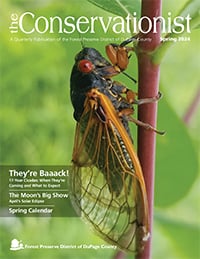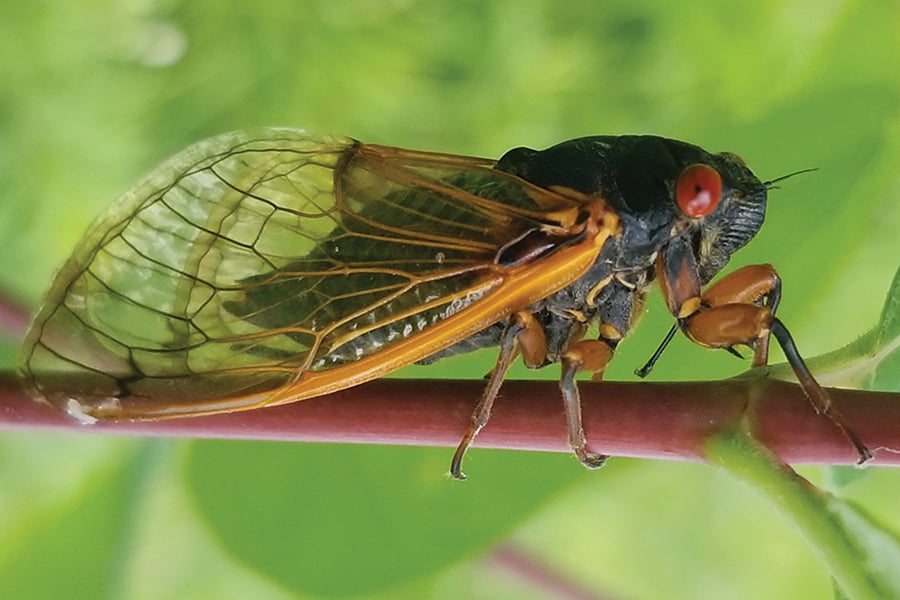
Conservationist Spring 2024
From the President

Spring is known as the season when everything starts to come alive, when everything begins to blossom and change and people are eager to get outside. This spring especially, DuPage forest preserves are going to be the place to go to experience some rare natural events.
First off, we’ll be witnessing a near total solar eclipse on April 8. You can read how this affects wildlife and how to safely view the eclipse in “The Moon’s Big Show” on Page 16. Then, over a much longer time period we’ll be experiencing the return of the 17-year cicadas, a remarkable phenomenon that illustrates how some of the area’s wild creatures have developed amazing methods for survival. You can find out why 2024 is going to be a rare emergence in “They’re Baaack” on Page 6.
Of course, we’ll also have some DuPage forest preserve exclusives, such as our springtime programs, which are featured in this issue’s calendar and include our annual Native Plant Sale. The sale will be on May 17 and 18, but you can begin to peruse the catalog starting March 1 on dupageforest.org.
Late last year the District conducted a countywide survey to assess the level of support, use, and opinions of our residents. The results show a high level of support for the agency. Of those surveyed, 82% have a favorable view of the District, and 60% believe we offer a positive value relative to our property tax share. On a scale of 1 to 10, we ranked 8.3 in overall experience and satisfaction, cleanliness, maintenance, upkeep, and access.
But we also found that many people are still not aware of all the great open spaces, programs, and activities the forest preserves offer. That’s why this spring we’re kicking off a special campaign designed to spread the word. You can join our efforts by talking about your own forest preserve experiences with friends and neighbors and following and sharing our posts on social media. Help us ensure that no one misses out on the different ways to enjoy spring in DuPage forest preserves!
Daniel Hebreard
President, Forest Preserve District of DuPage County
News & Notes
Collections Corner
With all the buzz about 17-year cicadas, “Collections Corner” just had to join the fun!
The Forest Preserve District’s natural history collection has a drawer dedicated to the annual and periodical cicadas of DuPage. One section has annual dog day and scissor-grinder cicadas, which appear here each summer. But the larger section has two species of 17-year periodical cicadas, Cassin and Linnaeus, most collected in 2007 during the area’s last emergence. Interestingly, just as a few members of this year’s brood emerged one or two years early, there are three Cassin specimens from the 2007 brood collected in 2003. Keeping these specimens in the collection allows staff to record the biological diversity of the species and document changes over time.
Stop by Fullersburg Woods Nature Education Center while the cicadas are buzzing to see this collection and gaze upon the ancestors of these marvelous creatures!
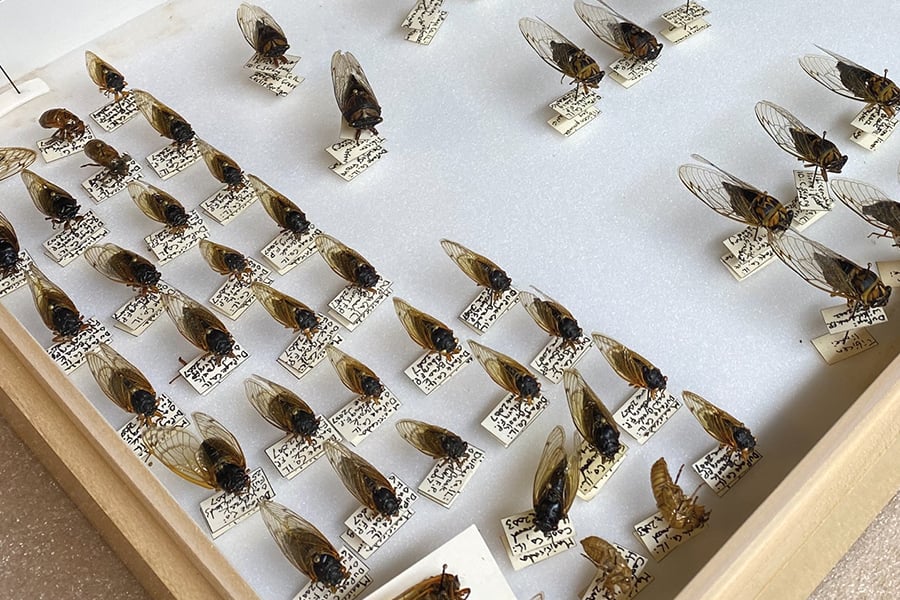
Thank You, Volunteers!
In recognition of National Volunteer Week, April 21 – 27, the Forest Preserve District applauds its 734 long-term volunteers and 80 volunteer groups. Last fiscal year, these dedicated individuals donated more than 57,000 hours with an in-kind value of nearly $1.9 million!
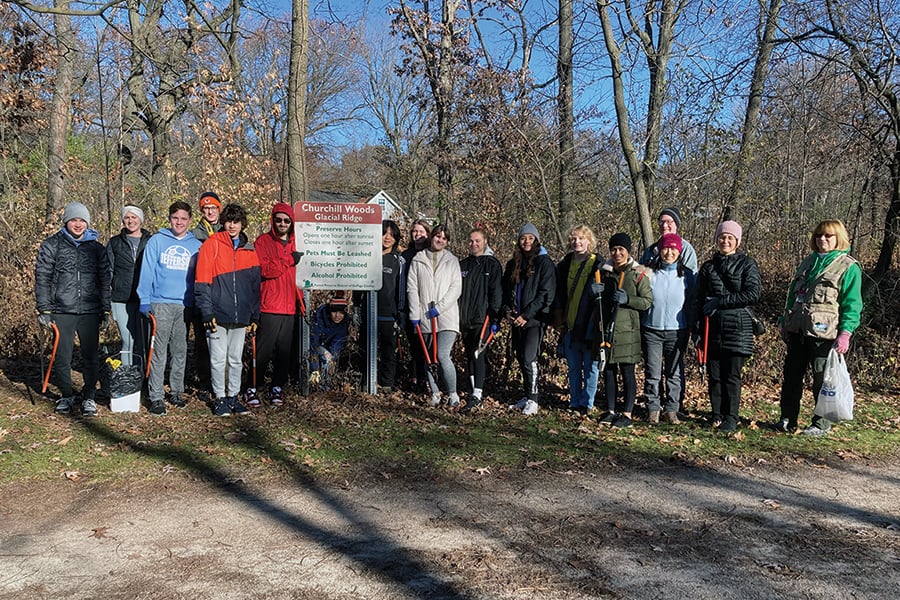
Where Nature and Art Meet
The District is gearing up to cohost a special summer and fall exhibit led by the College of DuPage Public Art Project, the DuPage Convention and Visitors Bureau, and the Mexican Cultural Center DuPage. Select forest preserves and other sites across DuPage will display fiberglass sculptures representing the ancient Mesoamerican Olmec culture. The original large-scale stone Olmec heads are recognized as
important examples of pre-Columbian art. Each sculpture will be uniquely painted by U.S. and international artists.
The exhibit will support District efforts to connect people to nature at its preserves and education sites while promoting environmental awareness, cross-cultural understanding, and the preservation of cultural heritage. It will also reinforce the District’s long-standing formal partnership with the visitors bureau.
The District’s investment will be limited to in-kind contributions of staff time to coordinate and promote the exhibit. Visit dupageforest.org later this spring for the locations and descriptions of these amazing works of art.
If You Care, Leave Them There
With the arrival of the spring breeding season, Willowbrook Wildlife Center reminds residents that it’s normal for wildlife to leave young alone for hours at a time while they look for food. Human intervention may be helpful, though, if an animal is injured or truly abandoned. Call Willowbrook at 630-942-6200, or email willowbrook@dupageforest.org for guidance. Calls are answered daily 9 a.m. – 4 p.m., and recordings provide after-hours info.
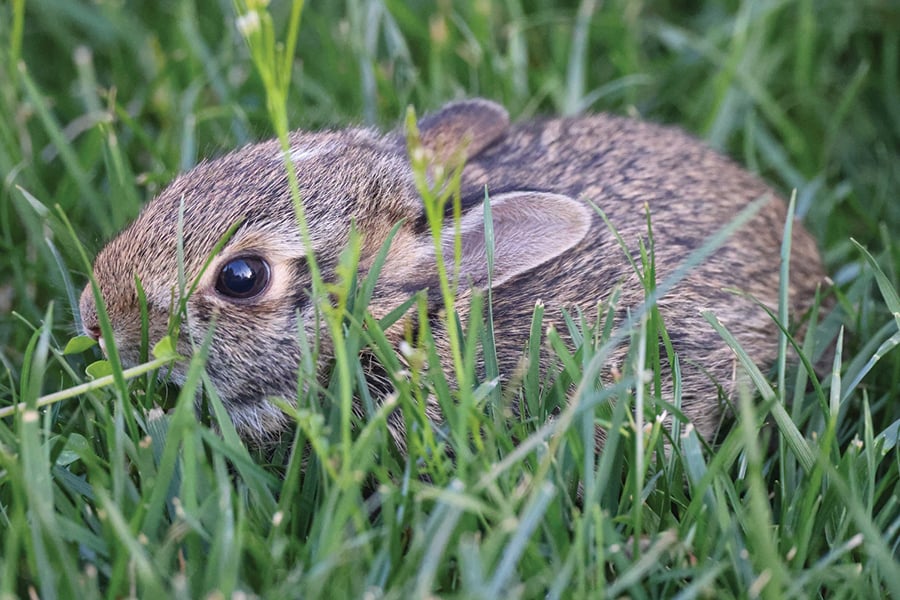
Thank You for Being a Friend
The Friends of the Forest Preserve District of DuPage County is a 501(c)(3) that engages the community in philanthropy to advance the mission of the Forest Preserve District. We are grateful to those who donated $500 or more (including cumulative donations) through the Friends or to the District during last year’s fourth quarter.
In 2023 over 1,000 individuals, corporations, and foundations donated to advance the Forest Preserve District’s mission. Thanks to their generosity, the Friends was able to grant $253,251 to the District for wildlife rehabilitation at Willowbrook Wildlife Center (60%); the Mayslake Peabody Estate Master Plan (25%); educational programs (6%); habitat restoration (4%); recreational amenities and improvements (3%); and the Blanding’s turtle head-start program (2%). For more about the Friends and opportunities for partnerships and donations, contact fundraising@dupageforest.org or 630-871-6400.
Gift of $50,000 or More
Navistar, Inc.
Gift of $25,000 – $49,999
TC Energy
Gifts of $10,000 – $24,999
G. Carl Ball Family Foundation
Schwab Charitable
Gifts of $5,000 – $9,999
James and Karen Click
Dan Soline
Susan Trommer
Gifts of $3,500 – $4,999
Larry Larson
Mary J. Demmon Private Foundation
Michael and Diane Webb
Gifts of $2,000 – $3,499
Mary and Harold Bamford III
Elaine Novak Jans
Carol McGee
Robert Miller
Jerry and Jody Zamirowski
Gifts of $500 – $1,999
Anonymous
Diane and Joe Addante
Coral Baran
Seth Becker and Helen Nam
Helena Borenius
Robert and Marcy Cap
James and Valerie Carroll
Chicago Ornithological Society
Jennifer Chidlow
Cheryl Clark
DuPage Birding Club
Howard Goldstein and Peggy McGrath
Corryn Greenwood
Judith Grey
H. Susan Jones Charitable Fund of DuPage Foundation
Paul Herbert
Keith and Tracy Hernandez
Izzie’s Garden
Ryan and Jeannine Kannegiesser
Tim and Kelsey Letizia
Lombard Juniors Philanthropic Fund
Mary Ann Mahoney
Gifts of $500 – $1,999 (Continued)
Guy and Sharon Matthew
Belinda Morgan
Naperville Animal Control
Roger and Susan Nelson
Donald and Susan Panozzo
John Schofield
John and Maria Shalanko
Steven and Megan Shebik
Janet Strain
Steven Szafranski
John and Marion Tableriou
Terri Tarka
Diane Telander
Frank and Patricia Troost
Robert Watt
West Chicago Garden Club
Heather and Mark Yeager
Doug Zimmer
They're Baaack! The Return of the Periodical Cicadas
The year 1803 was a notable one in U.S. history. Thomas Jefferson was president, the country nearly doubled in size with the Louisiana Purchase, and Ohio became the 17th state in the union. It was also the year of a spectacular natural phenomenon: the joint emergence of two broods of periodical cicadas. This spring and summer will mark the first time in 221 years this will happen again, and one of the broods will be here in DuPage.
Cicadas have an interesting journey of development. As young nymphs, they spend years underground, feeding on fluids from the roots of trees. After they surface as adults, they climb to high locations and go through one last molt, emerging soft and white from their rigid exoskeletons. You can often find the remaining hollow shells attached to tree trunks or on the ground. After a few short days, their wings and new exoskeletons dry and harden, and the insects fly away.
To attract females, male cicadas produce loud distinctive calls that can seem deafening to anyone standing nearby. After mating, the females puncture the twigs of trees and shrubs and lay their eggs inside. Days later, the eggs hatch, and the newborn cicadas fall and burrow into the soil, starting the process again.
Annual dog day cicadas spend between two to five years underground, and there are always adults emerging every July and August. They’re 1.25 to 1.5 inches long and have green to brown bodies with black markings and whitish undersides. Periodical cicadas, though, burrow for 13 or 17 years, depending on the species, and emerge all in the same year. Seven different types live in eastern North America: three 17-year species generally in the north and four 13-year in the south and Midwest. Adults are about an inch long and have black bodies, striking red eyes, orange wing veins, and a black W near the tips of their forewings.
After their final molt, male periodical cicadas live about two weeks. Females live four to six, during which time each can lay up to 600 eggs. Young the size of small ants hatch after six or seven weeks, fall to the ground, and burrow. When they emerge 13 or 17 years later, they exit through openings in the ground about half the diameter of a penny.
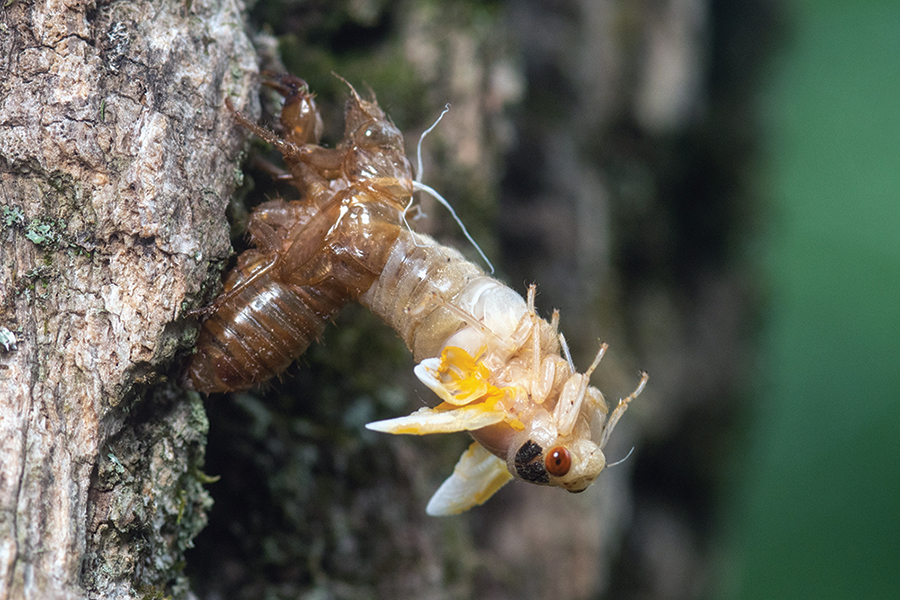
A cicada molts for one last time. Once the exoskeleton hardens and the wings unfurl, it will be a winged adult.
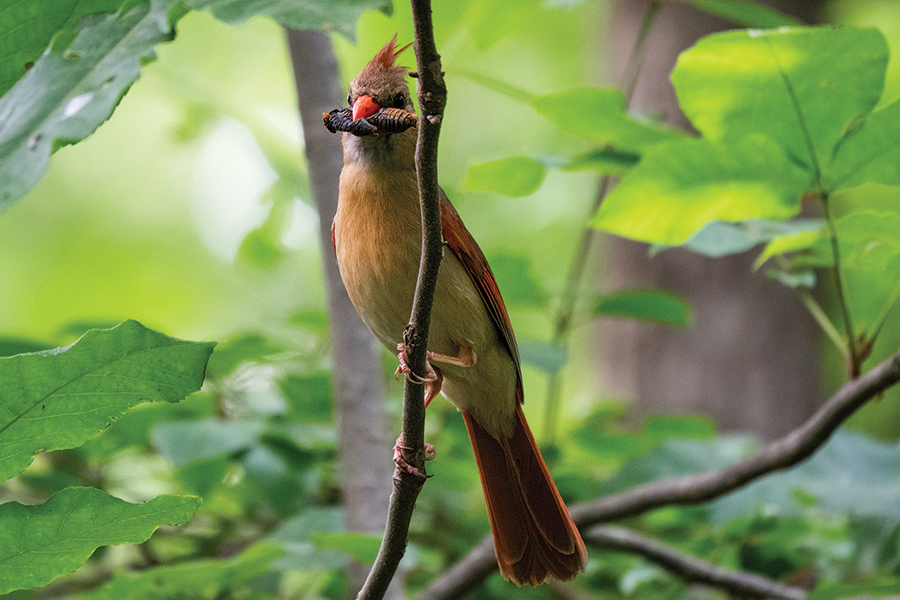
Animals gorge on periodical cicadas, but the enormous broods ensure there’ll be survivors to lay eggs for the next generation.
As in 1803, this year, 17-year cicadas (called Brood XIII) and 13-year cicadas (called Brood XIX) will emerge at the same time. It’s weather-dependent, but the peak will likely be between May and June. Before you anticipate a double dose, though, know that here in Illinois, the two broods will emerge adjacent to one another but will likely not overlap. In DuPage, we’ll see Brood XIII; Brood XIX will appear further south. According to maps and records from the Illinois Natural History Survey, the transition zone will likely be between Kankakee, Chebanse, and Clifton as you head south on I-57. There are no guarantees, but if you’re interested in trying to experience both broods at the same time, your best bet would be a short car ride to a public green space with mature trees along this stretch.
There are physical differences between broods, but the average observer will likely not notice them. Different cicada species, for instance, can produce different sounds, patterns, and frequencies. Each species has its own song so as not to attract females from another species. If you’re interested in trying to hear the differences, you can find links to several cicada calls at cicadamania.com.
Here in DuPage, it should be easy to find 17-year cicadas in backyards and forest preserves, whether you’re a trained scientist or a curious first-time observer. Because periodical cicadas emerge all in the same year, they arrive in high densities that can range from over a million per acre to a more typical several thousand per acre. They’re virtually defenseless from predators such as birds, spiders, snakes, and dogs, so they rely on this safety in numbers to ensure enough individuals survive to produce the next generation.
If (well, more likely when) you encounter a cicada, you have nothing to fear. They don’t bite or sting, and they typically keep to themselves. They can startle you, though, especially the males, which call not only to attract mates but also to deter perceived threats.
When you’re out, bring binoculars if you want to spot cicadas up high attached to large trees, but you can usually see them on the ground without any help. They typically fly and buzz during the day with peak activity from afternoon through dusk, so you’ll have plenty of opportunities to enjoy the show.
As you’re out observing, consider taking photos and posting them to community science apps such as iNaturalist or Cicada Safari. Both apps are free and allow you to share sightings with specialists so they can better understand nature on a regional scale. In DuPage forest preserves you can catalog your cicada or other nature observations in iNaturalist at inaturalist.org/projects/forest-preserve-district-of-dupage-county.
To experience this rare natural event to the fullest in the forest preserves, check out our lineup of “Cicada Adventures” programs on Page 10. And as you explore the preserves this May and June, relish the fact that you are part of something that lasts for only six weeks but was over 200 years in the making!
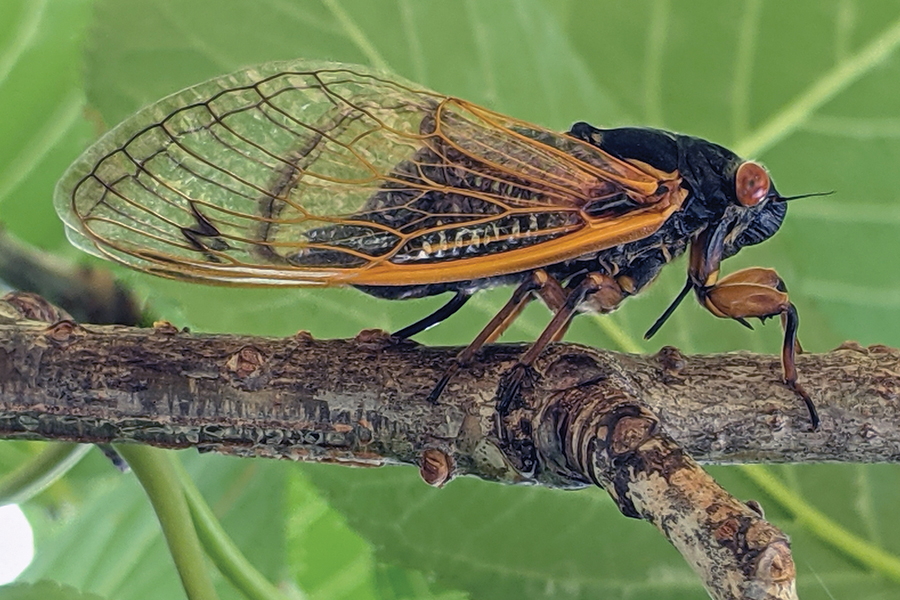
A female 17-year periodical cicada uses its ovipositor at the end of its abdomen to pierce a small twig and deposit its eggs.
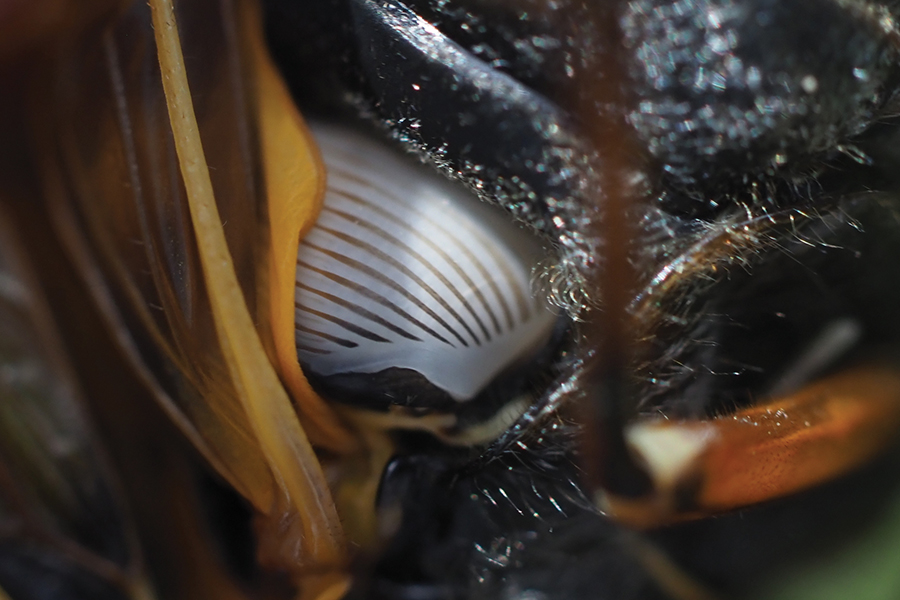
A small thin membrane called a tymbal below a cicada’s wings is responsible for the insect’s tremendous calls.
The Moon's Big Show
On Aug. 21, 2017, I was hiking along the Appalachian Trail somewhere in the Green Mountain National Forest just south of Rutland, Vermont. I didn’t know it when I set out, but I was about to witness one of our planet’s most fascinating occurrences, a solar eclipse. It wasn’t a total eclipse, meaning I didn’t experience the eerie dimming of light and drop in temperature, but I did enjoy the smattering of thousands of crescent sun shadows dappling the woodsy trail through the trees. (I didn’t have any protective solar eclipse glasses, so I was thrilled to see it through the shadows.) This year on April 8, we’ll have the chance to experience an eclipse closer to home right here in DuPage forest preserves.
For centuries, humans attributed eclipses to angry dragons, upset gods, hungry pumas, and other agents. Only 2,500 years ago did the first few individuals start to consider that the moon was involved. Today, we know we have eclipses because of the moon, but the reason is still fascinating.
The sun is 400 times bigger than the moon, but because the Earth is so close to the moon (239,000 miles) and so far from the sun (93 million miles) and the diameters of the moon and sun are what they are (2,159 and 865,000 miles, respectively), when things line up just right, the moon is able to block the entire fiery sphere from our view. It’s a remarkable event considering no other moon in our solar system (there are 290) can totally eclipse the sun in this way.
Even though the moon circles the Earth once a month, globally, eclipses occur just two to three times a year and only along a narrow band. Why? Well the moon’s ellipse (its orbit around the Earth) isn’t perfectly round and doesn’t sit directly along our equator. It’s also tilted at a 5-degree angle, so the moon is rarely in the right spot to cause an eclipse.
In our area, on April 8, beginning at 12:51 p.m. the moon will begin to eclipse the sun. It’s being called a “total” eclipse because along the center of its path the moon will block the sun completely. Here in DuPage, though, at its peak at
2:07 p.m., it will cover only 95%, leaving a small crescent of light. (If you want to see 100% and have friends in Carbondale, Illinois, you might want to pay them a visit.) According to NASA, our area won’t see a 100% eclipse until Sept. 14, 2099. In any case, this year’s show will be over at 3:22 p.m.

Solar eclipses occur when the moon is in just the right spot between the Earth and sun so that it blocks the sun’s light.

The author experienced the 2017 eclipse by safely viewing the crescent-shaped sunbeams that fell through the trees.
Even though we now understand what causes an eclipse, we’re still learning how plants and animals react to one. We learn more with each one, and although many observations have been anecdotal, they’re fascinating none the less. For example, during the window of an eclipse, people have seen birds go to roost, many falling completely silent. When the light returns, observers have noted bird songs like that at dawn. It makes sense when you consider that birds, like much of life, rely on light to dictate their circadian rhythms and behaviors.
Other animals seem to return to their nocturnal behaviors during an eclipse as well. Bees have been spotted returning to their hives, and people have reported an increase in mosquitoes, the emergence of bats, and the sounds of frog and cricket songs, all that usually occur around dusk.
Light also affects how plants behave. Studies show that transpiration in trees — the way water moves from the roots to the small pores in the leaves — slows during eclipses. Photosynthesis also slows down as does the flow of tree sap. Not surprisingly, plants slowly return to regular activity once the sun returns.
With every eclipse we learn more about how life responds to this phenomenon, and there are ways you can help collect data to contribute to the effort. During the 2017 eclipse, 636 people across North America participated in a citizen science activity where they took pictures of plants and animals 30 minutes before, during, and 30 minutes after the eclipse. The experiment was called “Life Responds” and was conducted through iNaturalist, a citizen science app.
The project was a success. People submitted 2,750 pictures with 478 identified species. During the peak of the eclipse they observed chickens going to roost, noticed cicadas stop singing, and heard crickets start to chirp, with the pattern shifting into reverse as the moon moved on.
This year, the Forest Preserve District is collecting its own data through iNaturalist. Once you have the app downloaded to your phone, click the “Projects” button, and then enter “FPDDC Wildlife Observations: Solar Eclipse 2024” in the search box. Details on how to participate are under “About.”
Who knows what fascinating things we’ll observe! As the shadow of the moon sweeps across the Earth, look around you at the surrounding life here on Earth. How is it all responding to this strange occurrence? I like to think that this experience will remind me of how small I am and yet, at the same time, how connected I am to everything around me.
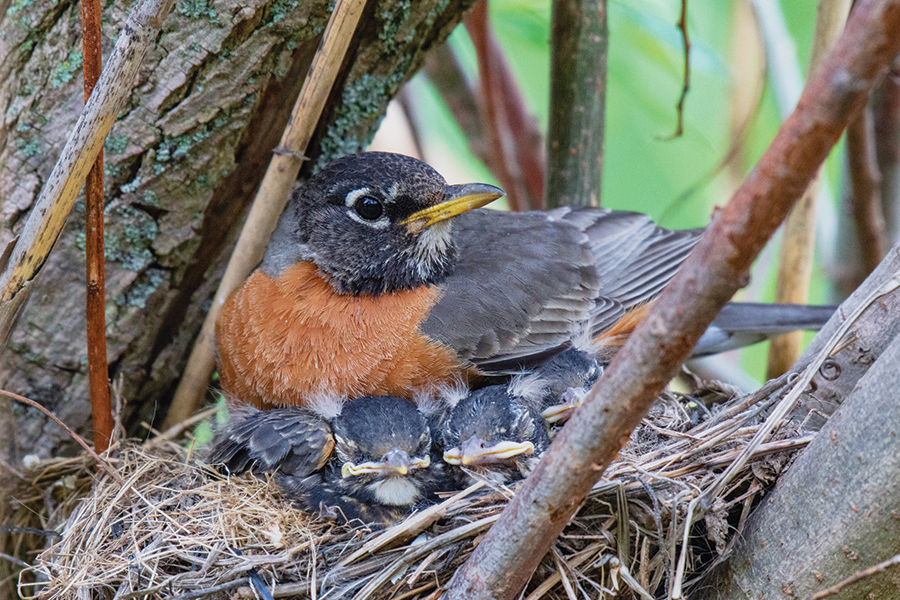
During an eclipse, people have observed birds returning to their nests as if it were dusk.
If you’re interested in watching this year’s eclipse (or any), never look at the sun without proper eye protection (and this doesn’t mean sunglasses). Even the slightest sliver of sunlight can permanently damage your eyes. NASA offers ways to safely view the eclipse at science.nasa.gov/eclipses. The page also takes you to a link with places where you can buy solar eclipse glasses that conform to the ISO 12312-2 international standard. There are fake glasses out there that will not protect your eyes, so it’s critical that you trust your source. The Forest Preserve District will have a limited supply of glasses on hand April 8 at Fullersburg Woods Nature Education Center, so stop by and enjoy some eclipse-themed activities! Details are on Page 10.

